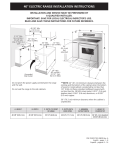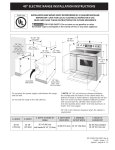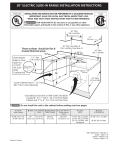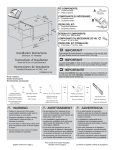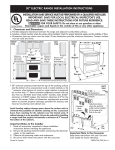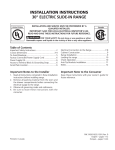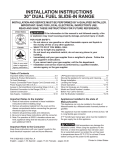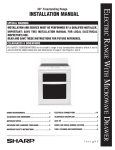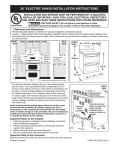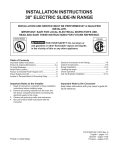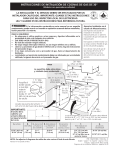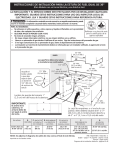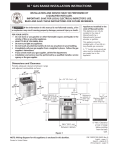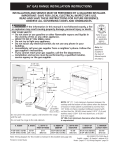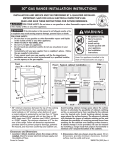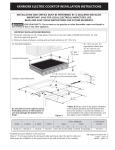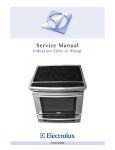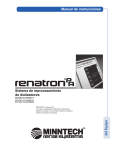Download 40" electric range installation instructions
Transcript
40" ELECTRIC RANGE INSTALLATION INSTRUCTIONS INSTALLATION AND SERVICE MUST BE PERFORMED BY A QUALIFIED INSTALLER. IMPORTANT: SAVE FOR LOCAL ELECTRICAL INSPECTOR'S USE. READ AND SAVE THESE INSTRUCTIONS FOR FUTURE REFERENCE. 40 1/8" Min. (101.9 cm) 2 1/2" Min. (6.4 cm Min.) On left side only, if there is a wall 27 ¾" (70.5 cm) with handle B 30" Min.** (76.2 cm Min.) 18" Min. 13" Min. (45.7 cm Min.) (33 cm Min.) 36" (91.4 cm) feet extended 47 ¼" (120 cm) Max. 24" Min. (61 cm Min.) 24 1/2" max. (62.2 cm Max.) Grounded Wall Outlet Do not pinch the power supply cord between the range and the wall. 43 ¾" (111.1 cm) With larger door open **NOTE: 24" (61 cm) minimum clearance between the cooktop and the bottom of the cabinet when the bottom of wood or metal cabinet is protected by not less than 1/4" (0.64 cm) flame retardant millboard covered with not less than No. 28 MSG sheet metal, 0.015" (0.4 mm) stainless steel, 0.024" (0.6 mm) aluminum, or 0.020" (0.5 mm) copper. Do not seal the range to the side cabinets. 30" (76.2 cm) minimum clearance when the cabinet is unprotected. A. HEIGHT B. WIDTH C. DEPTH TO FRONT OF RANGE D. DEPTH WITH DOOR OPEN E. MINIMUM CUTOUT WIDTH F. HEIGHT OF COUNTERTOP 36" (91.4 cm) 40 1/8" (101.9 cm) 25 1/2" (64.8 cm) 43 3/4" (111.1 cm) 40 1/4" (102.2 cm) 36" (91.4 cm) standard 35 3/8" (90 cm) min. 1 P/N 318201701 (0201) Rev. D English - pages 1 - 8 Español - páginas 9 - 16 40" ELECTRIC RANGE INSTALLATION INSTRUCTIONS • Make sure the wall coverings around the range can withstand the heat generated by the range. • Before installing the range in an area covered with linoleum or any other synthetic floor covering, make sure the floor covering can withstand heat at least 90°F/32°C above room temperature without shrinking, warping or discoloring. Do not install the range over carpeting unless you place an insulating pad or sheet of 1/4" (6.4 mm) thick plywood between the range and carpeting. • Do not obstruct the flow of combustion air at the oven vent nor around the base or beneath the lower front panel of the range. Avoid touching the vent openings or nearby surfaces as they may become hot while the oven is in operation. This range requires fresh air for proper burner combustion. Important Notes to the Installer 1. Read all instructions contained in these installation instructions before installing range. 2. Remove all packing material from the oven compartments before connecting the electrical supply to the range (see "Preparation", page 6). 3. Install the 4 shipping bolts from range packaging as range leveling legs (see "Leveling the Range", page 7) 4. Two anti-tip brackets MUST be removed from lower back of range and MUST be installed (see "Anti-Tip Bracket Installation", page 8). 5. Observe all governing codes and ordinances. 6. Be sure to leave these instructions with the consumer. Important Note to the Consumer Keep these instructions with your owner's guide for future reference. Never leave children alone or unattended in the area where an appliance is in use. As children grow, teach them the proper, safe use of all appliances. Never leave the oven door open when the range is unattended. IMPORTANT SAFETY INSTRUCTIONS • Be sure your range is installed and grounded properly by a qualified installer or service technician. • This range must be electrically grounded in accordance with local codes or, in their absence, with the National Electrical Code ANSI/NFPA No. 70—latest edition. • The installation of appliances designed for manufactured (mobile) home installation must conform with Manufactured Home Construction and Safety Standard, title 24CFR, part 3280 [Formerly the Federal Standard for Mobile Home Construction and Safety, title 24, HUD (part 280)] or when such standard is not applicable, the Standard for Manufactured Home Installation 1982 (Manufactured Home Sites, Communities and Setups), ANSI Z225.1/NFPA 501Alatest edition, or with local codes. • All ranges can tip. • Injury to persons could result. • Install anti-tip device packed with range. Stepping, leaning or sitting on the door(s) or drawer of this range can result in serious injuries and can also cause damage to the range. • Do not store items of interest to children in the cabinets above the range. Children could be seriously burned climbing on the range to reach items. • To eliminate the need to reach over the surface units, cabinet storage space above the units should be avoided. • Do not use the oven as a storage space. This creates a potentially hazardous situation. • Never use your range for warming or heating the room. Prolonged use of the range without adequate ventilation can be dangerous. • Do not store or use gasoline or other flammable vapors and liquids near this or any other appliance. Explosions or fires could result. • Reset all controls to the "off" position after using a programmable timing operation. To reduce the risk of tipping of the range, the range must be secured by properly installed antitip bracket (s) provided with the range. To check if the bracket (s) is installed properly, remove the lower panel or storage drawer and verify that the anti-tip bracket (s) is engaged. FOR MODELS WITH SELF-CLEAN FEATURE: • Remove broiler pan, food and other utensils before self-cleaning the oven. Wipe up excess spillage. Follow the precleaning instructions in the Owner's Guide. 2 40" ELECTRIC RANGE INSTALLATION INSTRUCTIONS Power Supply Cord Kit Electrical Connection to the Range The user is responsible for connecting the power supply cord to the connection block located behind the back panel access cover. This appliance is manufactured with the neutral terminal connected to the range. While connecting range, do not loosen the nuts which secure the terminal block to the range. Electrical failure or loss of electrical connection may occur. This appliance may be connected by means of permanent "hard wiring" (flexible armored or nonmetallic shielded copper cable), or by means of a power supply cord kit. Use only a power supply cord kit rated at 125/250 volts minimum, 40 amperes minimum and marked for use with ranges. See chart (below) for cord kit connection opening size and rating information. Cord must have either 3 or 4 conductors. Electrical Shock Hazard • Electrical ground is required on this appliance. • Do not connect to the electrical supply until appliance is permanently grounded. • Disconnect power to the circuit breaker or fuse box before making the electrical connection. • This appliance must be connected to a grounded, metallic, permanent wiring system, or a grounding connector should be connected to the grounding terminal or wire lead on the appliance. • Do not use the gas supply line for grounding the appliance. For mobile homes, new installations, recreational vehicles, or areas where local codes do not permit grounding through neutral, a 4 conductor power supply cord kit rated at 125/250 volts minimum, 40 amperes and marked for use with ranges should be used (see Figure 4). Terminals on end of wires must either be closed loop or open-end spade lugs with upturned ends. Cord must have strain relief clamp. Risk of fire or electrical shock exists if an incorrect size range cord kit is used, if the Installation Instructions are not followed, or if the strain relief bracket is discarded. Failure to do any of the above could result in a fire, personal injury or electrical shock. Three Conductor Wire Connection to Range (The 3-conductor cord or cable must be replaced with a 4-conductor cord or cable where grounding through the neutral conductor is prohibited in new installations, mobile homes, recreational vehicles or in other areas where local codes do not permit neutral grounding) If local codes permit connection of the frame grounding conductor to the neutral wire of the copper power supply cord (see Figure 3): Range Connection Opening Size Chart Refer to chart below for proper range connection opening size and power supply cord kit ampere rating information. See serial plate on range for kilowatt rating data. Range Kilowatt Rating Diameter (inches) of Range (See Serial Plate on Range) Minimum Connection Opening Cord kit Direct 120/240 Volts 120/208 Volts Ampere Rating Cord Kit Connection 0 -16.5 kW 0 -12.5 kW 40 Amp 16.6-22.5 kW 12.6-18.5 kW 50 Amp 1-3/8 in. 1-3/8 in. 1. Remove the 3 screws at the lower end of the rear wire cover, then bend the lower end of the rear wire cover (access cover) upward to expose range terminal connection block (see Figure 2). 1-1/8 in. 1-3/8 in. NOTE: Range is shipped from factory with 1 1/8" dia. hole as shown in figure 3. If a larger hole is required, punch out the knockout. 3-Wire Wall Receptacle 3-Wire Power Supply Cord Kit To gain access to lower terminal block bend lower back cover plate along row of holes shown here Figure 1 Figure 2 3 40" ELECTRIC RANGE INSTALLATION INSTRUCTIONS 2. Remove the 3 loose nuts (after you removed the rubber band) on the terminal block using 3/8" nut driver or socket. 3. Connect the neutral white wire of the copper power supply cord to the center silver-colored terminal of the terminal block, and connect the other wires to the outer terminals. Match wires and terminals by color (red wires connected to the right terminal, black wires connected to the left terminal). 4. Replace the 3 nuts on the terminal block (see figure 3). 5. Lower the terminal cover and replace the 3 screws. Four Conductor Wire Connection to Range (mobile homes) 1. Remove the 3 screws at the lower end of the rear wire cover, then raise the lower end of the rear wire cover (access cover) upward to expose range terminal connection block (see figure 2). 2. Remove the three loose nuts (after you removed the rubber band) on the terminal block using a 3/8" nut driver or socket. 3. Remove the grounding strap from the terminal block and from the appliance frame. 4. Connect the ground wire (green) of the copper power supply cord to the frame of the appliance with the ground screw, using the hole in the frame where the ground strap was removed (see Figure 4). 5. Connect the neutral of the copper power supply cord to the center silver-colored terminal of the terminal block, and connect the other wires to the outer terminals. Match wires and terminals by color (red wires connected to the right terminal, black wires connected to the left terminal). 6. Replace the 3 nuts on the terminal block (see figure 4). 7. Lower the terminal cover and replace the 3 screws. Silver colored Terminal M Co M Co P oun rd ou r la ti P nt d te ng la in te g Red wire Terminal Block White Wire (Neutral) Grounding Strap Black wire Terminal Block Silver Colored Terminal A strainrelief supplied by the user must be installed at this location To 240 V receptacle 1-1/8“ Dia. Direct Connection Hole. Punch out knockout for 1-3/8“ Dia. Cord Kit Hole 1-1/8“ Dia. Direct Connection Hole. Punch out knockout for 1-3/8“ Dia. Cord Kit Hole Figure 3 A user supplied strain-relief must be installed at this location M C ou or P nt d la in te g Red Wire Black Wire Neutral (White Wire) Ground (Bare Copper Wire) To 240 V receptacle NOTE: Be sure to remove the supplied grounding strap Figure 4 4 40" ELECTRIC RANGE INSTALLATION INSTRUCTIONS Where local codes DO NOT permit connecting the appliance grounding conductor to the neutral (white) wire or if connecting to 4-wire electrical system (see Figure 6). 1. Disconnect the power supply. 2. Separate the green (or bare copper) and white appliance cable wires. 3. In the circuit breaker, fuse box or junction box: a) Connect the white appliance cable wire to the neutral (white) wire. b) Connect the 2 black wires together. c) Connect the 2 red wires together. d) Connect the green (or bare copper) grounding wire to the grounding wire of the circuit breaker, fuse box or junction box. Direct Electrical Connection to the Circuit Breaker, Fuse Box or Junction Box If the appliance is connected directly to the circuit breaker, fuse box or junction box, use flexible, armored or non metallic sheathed copper cable (with grounding wire). Supply a U.L. listed strain-relief at each end of the cable. At the appliance end, the cable goes through the Direct Connection Hole (see figure 4) on the Cord Mounting Plate. Wire sizes (copper wire only) and connections must conform to the rating of the appliance. Where local codes permit connecting the appliance grounding conductor to the neutral (white) wire (see Figure 5).(The 3-conductor cord or cable must be replaced with a 4-conductor cord or cable where grounding through the neutral conductor is prohibited in new installations, mobile homes, recreational vehicles or in other areas where local codes do not permit neutral grounding) 1. Disconnect the power supply. 2. In the circuit breaker, fuse box or junction box: a) Connect the green (or bare copper) wire, the white appliance cable wire, and the neutral (white) wire together. b) Connect the 2 black wires together. c) Connect the 2 red wires together. Figure 6 4-Wire Electrical System (example: Junction Box) Figure 5 3-Wire (Grounded Neutral) Electrical System (example: Junction Box) 5 40" ELECTRIC RANGE INSTALLATION INSTRUCTIONS the cabinet. If back of range will not be flush with the wall (the location of the outlet may not allow the range to be positioned against the wall), draw a line on the floor where the back edge of the range will be. Now install anti-tip brackets (see "Anti-Tip Brackets Installation", page 8). Junction Box Location Locate junction box as shown in Figure 7. If a service cord is used, the wall receptacle should be located in accordance with the dimensions below. Center Line of Range If range will not be installed against a cabinet, move range into final position. Mark on the floor along both sides of the range. If back of range will not be flush with the wall (the location of the outlet may not allow the range to be positioned against the wall), draw a line on the floor where the back edge of the range will be. Now install anti-tip brackets (see "Anti-Tip Brackets Installation", page 8). 10" (25.4 cm) WALL 20" (50.8 cm) 10" (25.4 cm) R FLOO 7" Max. (17.8 cm Max.) Locate Electrical Hook-up Inside Shaded Area Center Line of Range Range Installation When unpacking the range, do not discard the 4 shipping bolts. These are to be replaced on the unit for use as leveling legs and height adjustments. Figure 7 Range Placement NOTE: 1. The back of the range may be installed directly against the rear wall of the structure. 2. These ranges conform to U.L. requirements for "0" spacing from the range to adjacent vertical walls above the countertop level. However, to reduce possible scorching of vertical walls and to minimize potential fire hazards under abnormal surface unit use conditions such as high heat or no pans, a minimum of 2" (5.1 cm) spacing should be provided on both sides of the cooktop. To eliminate the risk of burns or fire by reaching over heated surface units, cabinet storage space located above the range should be avoided. If cabinet storage space is to be provided, the risk can be reduced by installing a range hood that projects horizontally a minimum of 5" (12.7 cm) beyond the bottom of the cabinet. Preparation Center Line of Range Excessive Weight Hazard • Use 2 or more people to move and install range. • Failure to follow this instruction can result in back or other injury. Follow instructions for the type of installation you have Figure 8 1. Put on safety glasses and gloves. Remove oven racks and parts package from inside the oven. Remove shipping materials, tape and protective film from the range. 2. Take 4 cardboard corners from the carton. Stack one on top of another. Repeat with other 2 corners. Place corners lengthwise on the floor in back of the range to support range. 3. Firmly grasp the range and gently lay it on its back on the cardboard corners. 4. Remove and save the 4 shipping bolts from the skid. Discard skid. If range will be installed with a cabinet on both sides, draw a center line on the floor between the cabinets (see figure 8). If back of range will not be flush with the wall (the location of the outlet may not allow the range to be positioned against the wall), draw a line on the floor where the back edge of the range will be. Now install anti-tip brackets (see "Anti-Tip Bracket Installation, page 8). If range will be installed with a cabinet on one side only, move the range into final position. Draw a line on the floor along the side of the range that is not against 6 40" ELECTRIC RANGE INSTALLATION INSTRUCTIONS 2. Operation of Oven Elements The oven is equipped with an electronic oven control. Each of the functions has been factory checked before shipping. However, it is suggested that you verify the operation of the electronic oven controls once more. Refer to the Owner's Guide for operation. Follow the instructions for the Clock, Timer, Bake, Broil, Convection (some models) and Clean (some models) functions. 5. Install 4 shipping bolts as leveling legs. 6. Lay a large piece of cardboard in front of the range. Carefully stand the range upright on cardboard. 7. Adjust the leveling legs to a point where the range base does not touch the floor. Leveling the Range Level the range and set cooktop height before installation in the cut-out opening (if applicable). 1. Install an oven rack in the center of the oven. 2. Place a level on the rack (see figure 9). Take 2 readings with the level placed diagonally in one direction and then the other. Level the range, if necessary, by adjusting the 4 leg levelers with a wrench (see Figure 11). 3. Slide range into cut-out opening and double check for levelness. If the range is not level, pull unit out and readjust leveling legs, or make sure floor is level. Bake–After setting the oven to 350°F (177°C) for baking, the lower element in the oven should become red. Broil–When the oven is set to BROIL, the upper element in the oven should become red. Clean (some models)–When the oven is set for a selfcleaning cycle, the upper element should become red during the preheat portion of the cycle. After reaching the self-cleaning temperature, the lower element will become red. Convection (some models)–When the oven is set to CONV. BAKE/ROAST at 350°F (177°C), both elements cycle on and off alternately and the convection fan will turn. The convection fan will stop turning when the oven door is opened during convection baking or roasting. When All Hookups are Complete Make sure all controls are left in the OFF position. Model and Serial Number Location The serial plate is located on the oven front frame behind the large oven door. Figure 9 Check Operation Refer to the Owner's Guide packaged with the range for operating instructions and for care and cleaning of your range. When ordering parts for or making inquiries about your range, always be sure to include the model and serial numbers and a lot number or letter from the serial plate on your range. Do not touch the elements. They may be hot enough to cause burns. Before You Call for Service Read the Avoid Service Checklist and operating instructions in your Owner's Guide. It may save you time and expense. The list includes common occurrences that are not the result of defective workmanship or materials in this appliance. Remove all packaging from the oven before testing. 1. Operation of Surface Elements Turn on each of the four surface elements and check to see that they heat. Check the surface element indicator light(s), if equipped. Refer to the warranty and service information in your Owner's Guide for our phone number and address. Please call or write if you have inquiries about your range product and/or need to order parts. 7 40" ELECTRIC RANGE INSTALLATION INSTRUCTIONS 1. Unfold paper template and place it flat on the floor with the back and side edges positioned exactly where the back and sides of range will be located when installed. (Use the diagram in figure 10 to locate brackets if template is not available.) 2. Mark on the floor the location of the 4 mounting holes (2 holes per bracket) shown on the template. For easier installation, 3/16" (4.8 mm) diameter pilot holes ½" (1.3 cm) deep can be drilled into the floor. 3. Remove template and place brackets on floor with turned up flanges to the outside (see figure 10). Line up holes in brackets with marks on floor and attach with 4 screws provided (2 screws per bracket). Brackets must be secured to solid floor. If attaching to concrete floor, first drill 3/16" (4.8 mm) dia. pilot holes using a masonry drill bit. 4. Level range if necessary, by adjusting 4 leg levelers with wrench. (See Figure 11). A minimum clearance of 1/8" (3.2 mm) is required between the bottom of the range and the rear leg levelers to allow room for the anti-tip brackets. 5. Slide range into place making sure rear legs are trapped by ends of brackets. Range may need to be shifted slightly to one side as it is being pushed back to allow rear legs to align with brackets. 6. After installation, verify that the anti-tip bracket is engaged. Open and remove drawer and check to make sure the anti-tip bracket is engaged. Important Safety Warning To reduce the risk of tipping of the range, the range must be secured to the floor by properly installed anti-tip brackets and screws packed with the range. Those parts are located in a plastic bag in the oven. Failure to install the anti-tip brackets will allow the range to tip over if excessive weight is placed on an open door or if a child climbs upon it. Serious injury might result from spilled hot liquids or from the range itself. Follow the instructions below to install the anti-tip brackets. If range is ever moved to a different location, the anti-tip brackets must also be moved and installed with the range. To check for proper installation, see step 5. Tools Required: 5/16" (8 mm) Nutdriver or Flat Head Screwdriver Adjustable Wrench Electric Drill 3/16" (4.8 mm) Diameter Drill Bit 3/16" (4.8 mm) Diameter Masonry Drill Bit (if installing in concrete) Anti-Tip Brackets Installation Instructions Brackets attach to the floor at the back of the range to hold both rear leg levelers. When fastening to the floor, be sure that screws do not penetrate electrical wiring or plumbing. The screws provided will work in either wood or concrete. Anti-Tip Bracket Slide Back ¾" (1.9 cm) Anti-Tip Bracket 1/2" (1.3 cm) Sides of range ¾" (1.9 cm) Figure 10 Figure 11 8 INSTRUCCIONES DE INSTALACION PARA LA ESTUFA ELECTRICA DE 40" LA INSTALACION Y EL SERVICIO DEBEN SER EFECTUADOS POR UN INSTALADOR CALIFICADO. IMPORTANTE: GUARDE ESTAS INSTRUCCIONES PARA USO DEL INSPECTOR LOCAL DE ELECTRICIDAD. LEA Y GUARDE ESTAS INSTRUCCIONES PARA REFERENCIA FUTURA. 40 1/8" Mín. (101.9 cm) 2 1/2" Mín. (6.4 cm Mín.) Si hay uno pared, el lado izquierdo solamente 27 ¾" (70.5 cm) Con la manija B 30" Mín.** (76.2 cm Mín.) 18" Mín. 13" Mín. (45.7 cm Mín.) (33 cm Mín.) 36" (91.4 cm) con las patas extendidas 47 ¼" (120 cm) máx. 24" Mín. (61 cm Mín.) 24 1/2" Máx. (62.2 cm Máx.) Toma corriente de pared puesto a tierra No pellizque el cordón eléctrico entre la estufa y la pared. 43 ¾" (111.1 cm) Con la puerta grande abierta **NOTA: Un espacio mínimo de 24" (61 cm) entre la superficie de la estufa y el fondo del armario cuando el fondo del armario de madera o metal está protegido por no menos de 1/4" (0.64 cm) de madera resistente al fuego cubierta por una lámina metálica de MSG, número 28, 0.015" (0.4 mm) de acero inoxidable, 0.024" (0.6 mm) de aluminio, ô 0.02" (0.5 mm) de cobre. No selle la estufa a los armarios de lado. Un espacio mínimo de 30" (76.2 cm) cuando el armario no está protegido. A. ALTURA B. ANCHURA 36" (91,4 cm) 40 1/8" (101.9 cm) C. PROFUNDIDAD AL D. PROFUNDIDAD CON FRENTE DE LA ESTUFA PUERTA ABIERTA 25 1/2" (64,8 cm) 43 3/4" (111.1 cm) 9 E. MÍNIMO DE ANCHO ESPACIO RECORTADO F. ALTURA DE MOSTRADOR 40 1/4" (102.2 cm) 36" (91.4 cm) normal 35 3/8" (90 cm) min. P/N 318201701 (0201) Rev. D English - pages 1 - 8 Español - páginas 9 - 16 INSTRUCCIONES DE INSTALACION PARA LA ESTUFA ELECTRICA DE 40" • Asegúrese de que el material que recubre las paredes alrededor de la estufa, pueda resistir el calor generado por la estufa. • Antes de instalar la estufa en un área cuyo piso este recubierto con linóleo u otro tipo de piso sintético, asegúrese de que éstos puedan resistir una temperatura de por lo menos 90°F sobre la temperatura ambiental sin provocar encogimiento, deformación o decoloración. No instale la estufa sobre una alfombra al menos que coloque una plancha de material aislante de por lo menos 1/4 pulgada, entre la estufa y la alfombra. • No obstruya el flujo del aire de combustión en la ventilación del horno ni tampoco alrededor de la base o debajo del panel inferior delantero de la estufa. Evite tocar las aberturas o áreas cercanas de la ventilación, ya que pueden estar muy calientes durante el funcionamiento del horno. La estufa requiere aire fresco para la combustión apropiada de los quemadores. Notas importantes para el Instalador 1. 2. 3. 4. 5. 6. Lea todas las instrucciones contenidas en este manual antes de instalar la estufa. Saque todo el material usado en el embalaje del compartimiento del horno antes de conectar el suministro eléctrico a la estufa. Guarde los 4 pernos del empaque de la estufa para usarlos como patas niveladoras. Dos soportes antivuelco DEBEN quitarse de la parte de inferior trasera de la estufa y DEBEN ser instalados. Para detalles, vea instrucciones en la páginas 16. Observe todos los códigos y reglamentos pertinentes. Deje estas instrucciones con el comprador. Nota Importante para el Consumidor Conserve estas instrucciones y el Manual del Usuario para referencia futura. IMPORTANTES INSTRUCCIONES DE SEGURIDAD Nunca deje niños solos o desatendidos en un área donde un artefacto está siendo usado. A medida que los niños crecen, enséñeles el uso apropiado y de seguridad para todos los artefactos. Nunca deje la puerta del horno abierta cuando la estufa está desatendida. • Asegúrese de que la estufa sea instalada y conectada a tierra en forma apropiada por un instalador calificado o por un técnico. • Esta estufa debe ser eléctricamente puesta a tierra de acuerdo con los códigos locales, o en su ausencia, con el Código Eléctrico Nacional ANSI/ NFPA No. 70, última edición. • La instalación de aparatos diseñados para instalación en casas prefabricadas (móviles) debe conformar con el Manufactured Home Construction and Safety Standard, título 24CFR, parte 3280 [Anteriormente el Federal Standard for Mobil Home Construction and Safety, título 24, HUD (parte 280)] o cuando tal estandard no se aplica, el Standard for Manufactured Home Installation 1982 (Manufactured Home sites, Communities and Setups), ANSI Z225.1/NFPA 501Aedición más reciente, o con los códigos locales. • Todas las estufas pueden volcarse. • Esto podría resultar en lesiones personales. • Instale el dispositivo antivuelcos que se ha empacado junto con esta estufa. No se pare, apoye o siente en las puertas o cajones de esta estufa pues puede resultar en serias lesiones y puede también causar daño a la estufa. • No almacene artículos que puedan interesar a los niños en los gabinetes sobre la estufa. Los niños pueden quemarse seriamente tratando de trepar a la estufa para alcanzar estos artículos. • Los gabinetes de almacenamiento sobre la estufa deben ser evitados, para eliminar la necesidad de tener que pasar sobre los elementos superiores de la estufa para llegar a ellos. • No use el horno como espacio de almacenaje. Esto creará una situación potencialmente peligrosa. • Nunca use la estufa para calentar el cuarto. El uso prolongado de la estufa sin la adecuada ventilación puede resultar peligroso. • No almacene ni utilice gasolina u otros vapores y líquidos inflamables en la proximidad de éste o de cualquier otro artefacto eléctrico. Puede provocar incendio o explosión. • Ajuste todos los controles a la posición "OFF" (apagada) después de haber hecho una operación con tiempo programado. Para reducir el riesgo de que se vuelque la estufa, hay que asegurarla adecuadamente colocándole los soportes antivuelco que se proporcionan. Para comprobar si estos están instalados y apretados en su lugar como se debe, ase el borde trasero superior de la estufa y cuidadosamente inclínela hacia adelante para asegurar que la estufa se ancle. PARA MODELOS AUTOLIMPIANTES: • Saque la asadera, alimentos o cualquier otro utensilio antes de usar el ciclo de autolimpieza del horno. Limpié todo exceso de derrame de alimentos. Siga las instrucciones de prelimpiado en el Manual del Usuario. 10 INSTRUCCIONES DE INSTALACION PARA LA ESTUFA ELECTRICA DE 40" Juego de Cordón Eléctrico El consumidor tiene la responsabilidad de conectar el cordón eléctrico al bloque de conexión ubicado detrás de la cubierta de acceso del panel trasero. Receptáculo de Pared de 3 Alambres Juego de Cordón de Suministro Eléctrico de 3 Alambres Este artefacto puede ser conectado mediante "cableado rígido" permanente (un cable fexible escudido o un cable de cobre escudido no metálico) o un "juego de cordón eléctrico". Se usará solamente un juego de cordón eléctrico para 125/250 voltios mínimo, 40 amperios mínimo y marcado para uso con estufas. El juego de cordón eléctrico debe tener 3 o 4 conductores. Figura 1 Conexión Eléctrica de la Estufa Este aparato se fabrica con el terminal neutro conectado al marco. Para las casas sobre ruedas, las nuevas instalaciones, en los vehículos de recreación o en las áreas donde los códigos locales no permiten la conexión del conductor a tierra al neutro, un ensamblaje de suministro eléctrico de 4 conductores para estufas, clasificado a 125/250 voltios mínimo, 40 amperios mínimo, debe de ser utilizado (vea Figura 4). Riesgo de Choque Eléctrico • Una puesta a tierra está requerido en este aparato. • No lo conecte a la corriente eléctrica hasta que el aparato haya sido puesto a tierra permanentemente. • Desconecte la corriente eléctrica a la caja de empalmes antes de hacer la conexión eléctrica. • Este aparato debe estar conectado con un sistema de alambres puesto en tierra, metálico y permanente o un conector de puesta a tierra debe conectarse al terminal de puesta a tierra o el alambre conductor en el aparato. Los terminales en las puntas de los alambres deben ser de circuito cerrado o de orejeta de pala punta abierta y con las puntas vueltas hacia arriba. El cordón debe tener un anclaje del cable. Puede ocurrir riesgo de incendio o choque eléctrico si se usa un juego de cordón de estufa de tamaño incorrecto, si las instrucciones de instalación no son seguidas o si no se usa el anclaje del cable. La falta de hacer cualquier de las cosas arriba podría resultar en un incendio, choque eléctrico o lesiones personales. Tabla de tamaño de abertura de conexión de cocina Referirse a la tabla de arriba para el tamaño de abertura de connexión de cocina adecuada, y la información sobre el regimén de amperios del ensamblaje de cordón de suministro eléctrico. Vea la placa de serie de la cocina para información sobre el regimén de kilovatio. 120/240 Volts 120/208 Volts 0-16.5 Kw 0-12.5 Kw 16.6-22.5 Kw 12.6-18.5 Kw Conexión de tres alambres de conducción a la estufa Diametro (pulgadas) de Mínimo regimén de abierta de conexión de amperios cocina. de ensamblaje Dimensión Conexión del cordón agujero directo Connexión 40 Amp 50 Amp 1 3/8 pulg 1 3/8 pulg (Un cordón flexible o cable de 3 conductores debe de ser reemplazado con un cordón flexible o cable de 4 conductores donde la conexión del conductor a tierra al neutro esta prohibida en las nuevas instalaciones, las casas sobre ruedas, los vehículos de recreación o otras áreas donde los códigos locales no permiten la conexión a tierra al neutro.) Si los códigos locales permiten la conexión del conductor de tierra del marco con el alambre neutro del cordón eléctrico de cobre Para obtener acceso al (vea Figura 3): 1 1/8 pulg 1 3/8 pulg NOTA: La estufa viene de fábrica preparada para funcionar con un hueco de 1 1/8" de diametro come se muestra en la figura 3. En caso de necesitarse un hueco más grande retire la cubierta. Al realizar la conexión de la estufa, no desaprete las tuercas que aseguran el alambraje de la estufa al bloque terminal instalado en la fábrica. Se puede ocurrir corte de energía o pérdida de conexión eléctrica. Figura 2 11 tablero inferior de bornes, doble hacia atrás la placa de la cubierta trasera por la fila de agujeros que se ven aquí. INSTRUCCIONES DE INSTALACION PARA LA ESTUFA ELECTRICA DE 40" Conexión de 4 alambres de conducción a la estufa (casas móviles) 1. Quite los tres tornillos en la parte más baja del panel trasero, luego levante la parte más baja del panel trasero (la cubierta de acceso) exponiendo el bloque de conexiones de los terminales de la estufa (vea Figura 2). 2. Quinte las tres tuercas desatadas (después de remover la cinta de goma) sobre el bloque terminal usando un destornillador o una llave de casquillo de 3/8". 3. Conecte el cable neutro del cordón eléctrico de cobre al terminal de color de plata en el centro del bloque, y conecte los otros cabels a los terminales laterales. Empareje los cables y los terminales según el color (cables rojos conectados con el terminal derecho, cables negros conectados con el terminal izquierdo). 4. Baje la cubierta del terminal y reinstale los tres (3) tornillos. 5. Baje la cubierta del terminal y reponga los 3 tornillos. 1. Quite los tres tornillos en la parte más baja del panel trasero, luego levante la parte más baja del panel trasero (la cubierta de acceso) exponiendo el bloque de conexiones de los terminales de la estufa (vea figura 2). 2. Retire las 3 tuercas (después de haber removido la banda de goma) sobre el bloque terminal usando un manguito o destornillador de casquillo de 3/8" pulgadas. 3. Quite la banda de puesta a tierra del bloque de los terminales y del marco del artefacto. Retenga el tornillo de puesta a tierra. 4. Conecte el alambre de puesta a tierra (verde) del cordón eléctrico de cobre al marco del artefacto con el tornillo de puesta a tierra, usando el agujero en el marco donde se quitó el tornillo de puesta a tierra (vea figura 4). 5. Conecte el alambre neutro (blanco) del cordón eléctrico de cobre al terminal de color de plata en el centro del bloque y conecte los otros alambres al los terminales laterales. Conecte los alambres y terminales emparejando los colores (los alambres rojos conectsdos al terminal derecho, los alambres negros conectados al terminal izquierdo). 6.Reponga las 3 tuercas sobre el bloque terminal (vea figura 4). 7. Baje la cubierta de acceso y vuelva a poner los 3 tornillos. Terminal plata d Co de e la rd ó m pl n on ac ta a je Alambre Rojo Alambre Negro Una arazadera de releva provista debe de estar instalada a está ubicación Neutro (Alambre Blanco) Banda de puesta a tierra Hacia el 240 V receptáculo Bloque terminal Terminal plata Alambre Rojo 1-1/8“ Dia. Agujero de la conexión directa. Retira la arandela pre-cortada para 1-3/8“ Dia. Agujero 1-1/8“ Dia. Agujero de la Alambre conexión Negro directa.Retira la arandela pre-cortada para 1-3/8“ Dia. Agujero Figura 3 d Co de e la rd ó m pl n on ac ta a je Bloque terminal Neutro (Alambre Blanco) Puesta a tierra (cable de cobre) Una arazadera de releva provista debe de estar instalada a está ubicación Hacia el 240 V receptáculo NOTA: Asegurese de quitar la banda de puesta a tierra provista. Figura 4 12 INSTRUCCIONES DE INSTALACION PARA LA ESTUFA ELECTRICA DE 40" Donde los códigos locales NO permitan conectar el conductor de puesta a tierra del eléctrodoméstico al neutral (blanco), o si está conectado con un sistema a 4 alambres (vea figura 6): 1. Desconecte el suministro eléctrico 2. Separe el alambre verde (o cobre desnudo) y el alambre blanco del electrodoméstico. 3. En el cortacircuito, la caja de fusibles o la caja de empalmes. a. Conecte el alambre blanco del cable del eléctrodoméstico al alambre neutral (blanco). b. Conecte los 2 alambres negros juntos. c. Conecte los 2 alambres rojos juntos. d. Conecte el alambre verde (o de cobre desnudo) de la puesta a tierra del alambre al alambre de puesta a tierra del cortacircuito, de la caja de fusibles o de la caja de empalmes. Conexión eléctrica directa al cortacircuito, a la caja de fusibles o la caja de empalmes Si el aparato está conectado directamente al cortacircuito, a la caja de fusibles o a la caja de empalmes, use un cable blindado flexible o no metálico recubierto de cobre (con alambre a tierra). Provee una abrazadera releva de anclaje homologo UL a cada extremidad del cable. A la extremidad del eléctrodoméstico, el cable pase a través del agujero de la conexión directa (vea figura 4) en el cable de la placa de montaje. El tamaño de los alambres (alambre de cobre solamente) y las conexiones deben estar conforme al regimén del eléctrodoméstico. Donde los códigos locales permitan conectar el conductor de puesta a tierra del eléctrodoméstico al neutral (blanco) (vea figura 5): (Un cordón flexible o cable de 3 conductores debe de ser reemplazado con un cordón flexible o cable de 4 conductores donde la conexión del conductor a tierra al neutro esta prohibida en las nuevas instalaciones, las casas sobre ruedas, los vehículos de recreación o otras áreas donde los códigos locales no permiten la conexión a tierra al neutro.) 1. Desconecte el suministro eléctrico. 2. En el cortacircuito, la caja de fusibles o la caja de empalmes a) Conecte el alambre verde (o cobre desnudo), el alambre blanco del cable del eléctrodoméstico y el alambre neutral (blanco) juntos. b) Conecte los dos alambres negros juntos. c) Conecte los dos alambres rojos juntos. Figura 6 - Sistema eléctrico de 4 alambres (ejemplo caja de empalme) Figura 5 - Sistema eléctrico (ejemplo: caja de empalmes) de 3 alambres (a tierra neutral) 13 INSTRUCCIONES DE INSTALACION PARA LA ESTUFA ELECTRICA DE 40" Si la estufa se va a instalar con un armario a sólo un lado, mueva la estufa a su posición final. Marque el piso por el lado de la estufa que no estará contra el armario. Si la parte trasera de la estufa no estará a ras con la pared (la ubicación del tomacorriente puede que no permita que la estufa se pegue a ras con la pared), marque el piso donde el borde trasero de la estufa estará. Ponga el patrón en el piso y alinie el lado del patrón con la línea marcada en el piso. Alinie la parte trasera del patrón con la pared trasera o la línea marcada para la parte de atrás de la estufa. Situación de caja de unión Localice la caja de empalmes como se ve en la Figura 7. Si se usa un cordón de servicio, el receptáculo de pared debe estar localizado según las medidas que se indican abajo. Center Line of Range DE LA ESTUFA 10" (25.4 cm) ALL W PARED 20" (50.8 cm) Si la estufa no será instalada junta contra un armario, mueva la estufa a su posición final. Marque el piso por los dos lados de la estufa. Si la parte trasera de la estufa no estará a ras con la pared (la ubicación del tomacorriente puede que no permita que la estufa se pegue a ras con la pared), marque en el piso donde el borde trasero de la estufa estará. Ponga el patrón en el piso y alinie los lados del patrón con las líneas marcadas en el piso. Alinie la parte trasera del patrón con la pared trasera o la línea marcada para la parte trasera de la estufa (vea instalación del Soportes Antivuelco página 8). 10" (25.4 cm) R PISO LOO F 7" Max. (17.8 cm Max.) UBIQUE LO ELECTRICO Locate Electrical DENTRO DEL AREAHook-up Inside Shaded Area SOMBREADA Center Line of Range DE LA ESTUFA Figura 7 Construcción de los Armarios Instalación de la estufa Para eliminar el riesgo de quemaduras e incendios al tocar superficies sobrecalentadas, se debe evitar colocar espacio para armarios de almacenamiento sobre las estufas con elementos al descubierto. Si se instalan armarios sobre la estufa, se pueden reducir tales riesgos instlando una campana purificadora que se proyecta horizontalemente un mínimo de 5" (12.7 cm) más afuera de la parte inferior de los armarios. Mientras se desembala la estufa, ne deseche los cuatro (4) pernos de embabalaje. Reemplácelos como patas niveladoras y para ajustar la altura de la unidad. NOTA: 1. La parte trasera de la estufa puede ser directamente instalada a ras con la pared trasera de la estructura. 2. Estas estufas se conforman a los requerimientos U.L. para espaciamiento “0” desde la estufa hasta las paredes verticales adyacentes arriba del nivel del tablero. No obstante, para reducir la posibilidad de quemar las paredes verticales y para disminuir el posible peligro de incendio bajo condiciones anormales de uso de la tapa con hornillas como alto calor o la ausencia de cazuelas, se debe dejar un espacio de un mínimo de 2" (5.1 cm) en ambos lados de la tapa. Center Line of Range Follow instructions for Siga las instrucciones para el tipo de the type of installation you have instalación que usted tenga Preparación Figura 8 Si la estufa se va a instalar con un armario a ambos lados, marque el centro de la abertura del armario en el piso. Si la parte trasera de la estufa no estará a ras con la pared (la ubicación del tomacorriente puede que no permita que la estufa se pegue a ras con la pared), marque el piso donde estará el border trasero de la estufa. Ponga el patrón en el piso, alineando la línea del centro del patrón con la marca en el centro de la abertura del armario. Ponga el borde trasero del patrón a ras contra la pared trasera o la línea marcada para la parte de atrás de la estufa. Peligro de Peso Excesivo • Use 2 personas o más para mover e instalar la estufa. • Si no cumple con esta instrucción, puede resultar en daño a la espalda u otra lesión. 1. Póngase guantes y anteojos de seguridad. Quite las parrillas del horno y paquete de piezas de adentro del horno. Quite materiales de empaque, cinta y película protectiva de la estufa. 14 INSTRUCCIONES DE INSTALACION PARA LA ESTUFA ELECTRICA DE 40" 2. Tome las 4 esquinas de cartón de la caja de empaque. Colóquelas una encima de otra. Repita esta operación con las otras 2 esquinas. Coloque las esquinas longitudinalmente en el piso detrás de la estufa, para apoyarla. 3. Sujete firmemente la estufa y suavamente recuéstela en su respaldo, en las esquinas de cartón. 4. Quite y guarde los 4 pernos de empaque de la corredera. Descarte la corredera. 5. Instale los 4 pernos de transporte como patas de nivelación. 6. Ponge el cartón delante de la estufa. Cuidadosamente pare la estufa en el cartón. 7. Ajuste la patas de nivelación al punto en que la base de la estufa no toque el piso. 2. Funcionamiento de los Elementos del Horno El horno está equipado con un control electrónico. Cada función ha sido probada en la fábrica antes del transporte. Sin embargo, sugerimos que Ud. verifique el funcionamiento de los controles del horno una vez más. Véase el Manual del Usuario para la operación. Siga las instrucciones par el Reloj, Minutero, Cocer, Asar, Covección (algunos modelos) y las funciones de limpieza (algunos modelos). Nivelación de la estufa Limpieza/Clean (algunos modelos)–Cuando el horno está puesto para un ciclo de auto-limpieza, el element superior se pondrá rojo durante el período de precalentamiento del ciclo. Después de alcanzar la temperatura de auto-limpieza , el elemento inferior se pondrá rojo. Cocer/Bake–Después de poner el horno a 350°F (177°C) para cocer, el element inferior debe ponerse rojo Asar/Broil–Cuando está puesto para BROIL, el elemento superior se debe poner rojo. Nivele la estufa y ajuste la altura de la estufa antes de instalarla en la abertura. 1. Coloque una parrilla del horno en el centro del horno. 2. Ponga un nivel sobre la parrilla (vea figura 9). Tome dos lecturas con el nivel puesto diagonalmente en una dirección y después en la otra. Nivele la estufa, si es necesario, ajustando las 4 patas niveladoras con una llave de tuercas (Figura 10). 3. Deslice la estufa en la abertura y verifique la nivelación otra vez. Si la estufa no es nivelada, tire la unidad hacia afuera y reajuste las patas niveladoras, o verifique que el piso sea nivelado. Convección/Convection (algunos modelos)–Cuando el horno se pone a CONV. BAKE/ROAST a 350°F (177°C), los dos elementos se enciendan y se apagan alternando en un ciclo y el ventilador se pone en marcha. El ventilador de convección se parará cuando se abre la puerta del horno durante el cocido o el asado por convección. Después de Terminar la Instalación Asegúrese de que todos los controles estén en la posición OFF (apagada). Ubicación del Número de Modelo y de Serie La placa con el número de serie está ubicada en el marco delantero del horno detrás de la puerta del horno grande. Cuando haga pedidos de repuestos o solicite información con respecto a su estufa, esté siempre seguro de incluir el número de modelo y de serie y el número o letra del lote de la placa de serie de su estufa. Figura 9 Comprobación del Funcionamiento Consulte el Manual del Usuario incluído con la estufa para instrucciones de operación y instrucciones para el cuidado y limpieza de su estufa. Antes de Llamar al Servicio Lea la sección Lista de control de averías en su Manual del Usuario. Esto le podrá ahorrar tiempo y gastos. Esta lista incluye ocurrencias comunes que no son el resultado de defectos de materiales o fabricación de este artefacto. No toque los elemento. Pueden estar bastante calientes para causar quemaduras. Quite todo el embalaje de la unidad antes de comprobarla. Lea la garantía y la información sobre el servicio en su Manual del Usuario para obtener el número de teléfono gratuito y la dirección del servicio. Por favor llame o escriba si tiene preguntas acerca de su estufa o necesita repuestos. 1. Operación de los elementos de superficie Encienda cada uno de los cuatro elementos de superficie y controle que se calienten. Verifique el funcionamiento de las luces indicadoras de los elementos de superficie, si equipadas. 15 INSTRUCCIONES DE INSTALACION PARA LA ESTUFA ELECTRICA DE 40" 1. Importante Advertencia de Seguridad Para reducir el riesgo de que la estufa se vuelque, es necesario asegurarla al piso instalando los soportes antivuelco y los tornillos suministrados con la estufa. Las piezas se encuentran en un saco de plástico en el horno. Si no se instalan los soportes antivuelco, la estufa se puede volcar si se coloca exceso de peso en una puerta abierta o si un niño se sube a ella. Se pueden ocasionar lesiones graves causadas por los líquidos calientes derramados o por la estufa misma. 2. 3. Siga las instrucciones que más abajo se indican para instalar los soportes antivuelco. Si la estufa es movida a otro lugar, los soportes antivuelco deben también ser movidos e instalados en la estufa. Para controlar la instalación apropiada, vea el paso número 5. Herramientas Necesarias: Llave de tuerca de 5/16" (8 mm) o destornillador para tornillos de cabeza plana Llave inglesa Taladro eléctrico Broca de 3/16" (4.8 mm) de diámetro Broca para taladro de mampostería de 3/16" (4.8 mm) de diá. (si se está instalando en concreto) 4. 5. Instrucciones de Instalación del Soporte Antivuelco Los soportes se fijan al suelo en la parte trasera de la estufa para sujetar ambos niveladores de las patas traseras. Cuando los esté instalando al piso, asegúrese de que los tornillos no penetren el alambrado eléctrico o plomería. Los tornillos provistos pueden utilizarse en madera o concreto. Deslice Hacia atras Pata niveladora Soporte Antivuelco Soporte Antivuelco P AR ED TR AS ¾" (1.9 cm) A ER 1/2" (1.3 cm) Desdoble la plantilla de papel y colóquela plana en el piso con los bordes laterales y el trasero colocados exactamente donde la parte trasera y los lados de la estufa serán colocados cuando sea instalada. (Use el diagrama siguiente para ubicar los soportes si no se dispone de la plantilla). Marque en el piso la ubicación de los 4 agujeros de montaje como se muestra en la plantilla. Para facilitar la instalación, se pueden taladrar agujeros piloto de 3/16" (4.8 mm) de diám. y 1/2" (1.3 cm) de profundidad en el piso. Saque la plantilla y coloque los soportes en el piso con la brida hacia arriba dirigida hacia el frente. Alinee los agujeros en los soportes con las marcas en el piso y sujete con los 4 tornillos provistos. Los soportes deben estar asegurados al piso firme. Si se va a instalar en piso de concreto, primero debe taladrar agujeros guía de 3/16" (4.8 mm) de diámetro usando una broca para taladro de mampostería. Nivele la estufa si es necesario ajustando las cuatro patas niveladoras con una llave (Ver la Figura 11 abajo). Se requiere un espacio libre mínimo de 1/8" (3.2 mm) entre la parte inferior de la estufa y los niveladores de las patas traseras para dejar espacio para los soportes antivuelco. Deslice la estufa a su lugar asegurándose de que las patas traseras estén sujetas por los extremos de los soportes. La estufa puede necesitar ser movida ligeramente a un lado cuando está siendo empujada hacia atrás para permitir que las patas se alineen con los soportes. Usted también puede asir el borde trasero de la cima de la estufa y cuidadosamente intentar voltearla para asegurarse de que la estufa sea adecuadamente anclada. A DE L DO FON STUFA E Lados de la estufa Levantar Bajar ¾" (1.9 cm) Figura 10 Figura 11 16
















